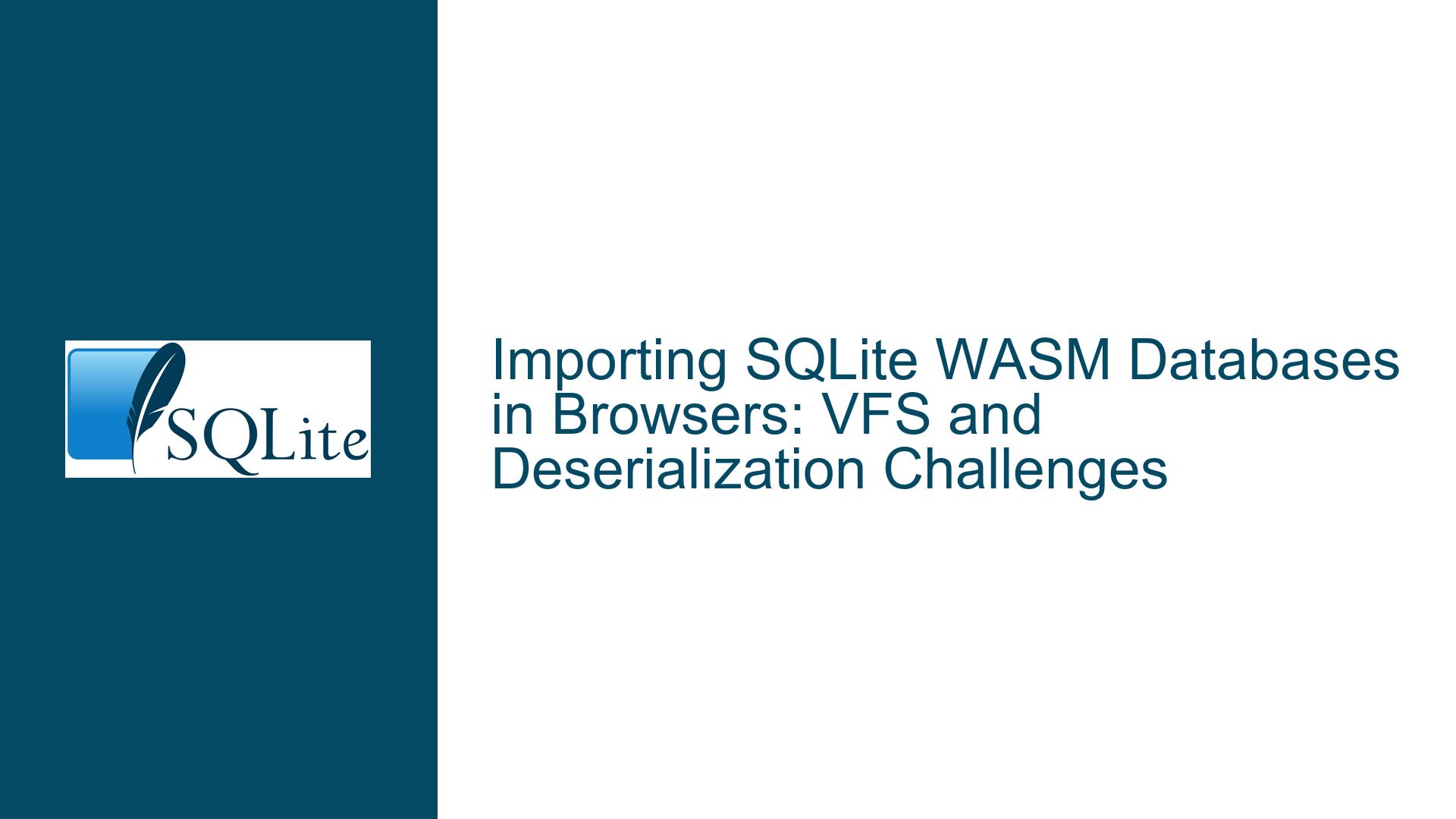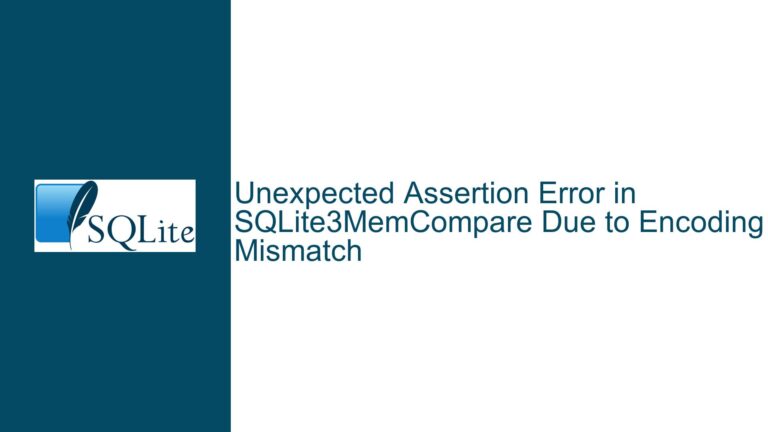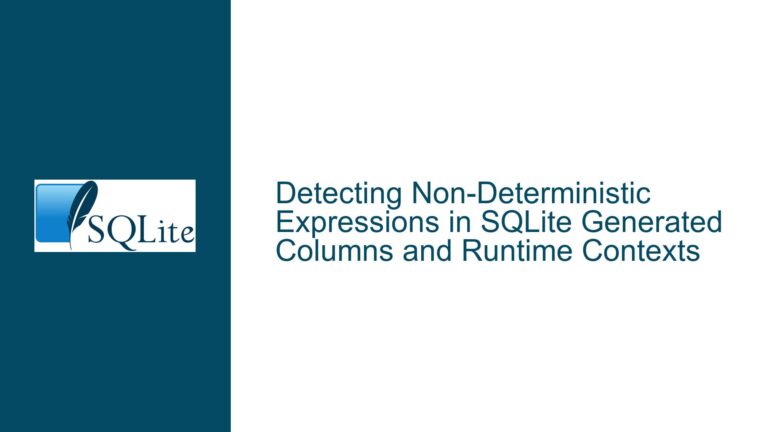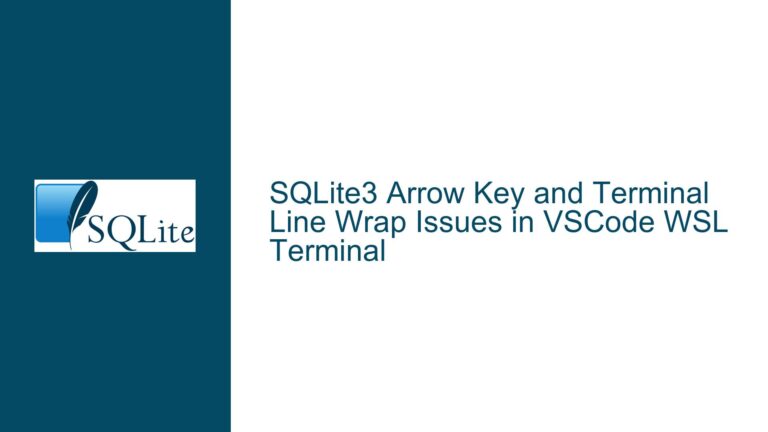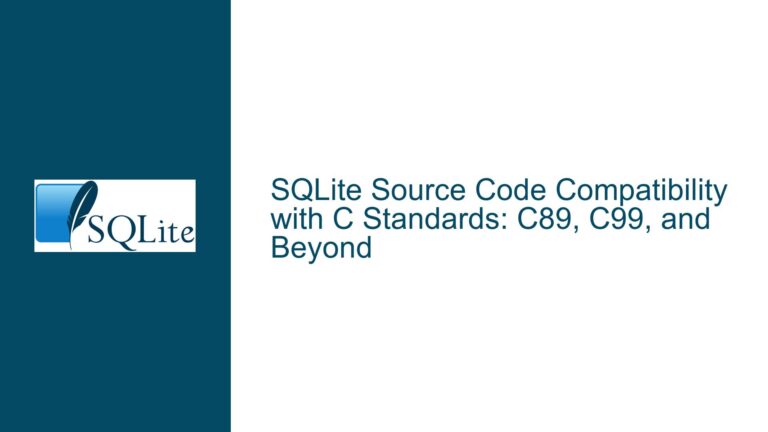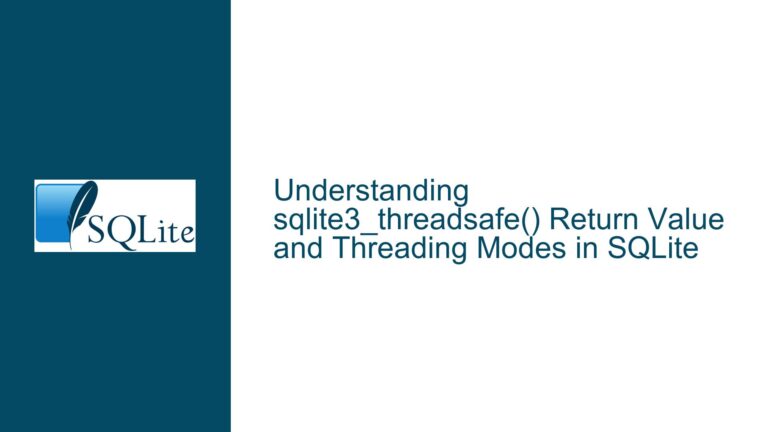Importing SQLite WASM Databases in Browsers: VFS and Deserialization Challenges
Browser-Based SQLite WASM Database Import: VFS Configuration and Deserialization Mechanics
Issue Overview: Database File Import Challenges in SQLite WASM Environments
The central challenge revolves around importing externally sourced SQLite database files into browser-based SQLite WASM environments while accounting for Virtual File System (VFS) layer constraints and memory management intricacies. Developers attempting to implement database upload functionality often encounter unexpected failures due to mismatches between JavaScript ArrayBuffer handling, SQLite’s VFS abstractions, and deserialization requirements.
At its core, the problem involves three interdependent factors:
- VFS-Specific Storage Requirements: Browser-based SQLite WASM implementations may utilize one of several VFS backends (in-memory, localStorage-backed kvvfs, Origin Private File System [OPFS]), each requiring distinct methods for writing database files.
- Deserialization Limitations: The
sqlite3_deserialize()API provides a mechanism to load database images directly into memory but imposes strict constraints on memory allocation strategies and database mutability post-import. - Allocator Compatibility: SQLite’s internal memory management system uses custom allocators that differ from browser JavaScript environment allocators, creating potential for memory corruption when transferring ownership of database buffers between WASM and JavaScript.
A typical implementation attempt involves fetching a database file via fetch(), converting it to an ArrayBuffer, then attempting to load it via sqlite3_deserialize(), only to encounter crashes during subsequent database operations or failures to persist changes. The root causes often stem from improper buffer allocation strategies or attempts to modify deserialized databases initialized with fixed-size memory buffers.
Possible Causes: VFS Mismatches, Allocation Incompatibility, and Deserialization Flags
1. VFS Storage Layer Configuration Conflicts
SQLite WASM environments default to an in-memory VFS unless explicitly configured to use OPFS or localStorage-backed kvvfs. Attempting to write a deserialized database image to a VFS that doesn’t support persistent storage (e.g., default in-memory VFS) results in ephemeral databases that disappear on page reload. Conversely, specifying a persistent VFS like OPFS without properly initializing the VFS layer causes file creation failures during import.
Example failure pattern:
const db = new sqlite3.oo1.DB('persistent.db', 'ct'); // Assumes OPFS VFS is active
// Fails if runtime environment uses default in-memory VFS
2. Improper Memory Allocation for Deserialization Buffers
The sqlite3_deserialize() function requires database buffers allocated via SQLite’s internal allocator (sqlite3_malloc() family). Developers commonly use sqlite3.wasm.allocFromTypedArray(), which relies on the system allocator (C malloc()), leading to undefined behavior when combined with flags like SQLITE_DESERIALIZE_FREEONCLOSE.
Critical code smell:
const p = sqlite3.wasm.allocFromTypedArray(bytes); // Uses system malloc()
sqlite3.capi.sqlite3_deserialize(
db.pointer, 'main', p, bytes.length, bytes.length,
sqlite3.capi.SQLITE_DESERIALIZE_FREEONCLOSE // Danger: mismatched allocator
);
3. Fixed-Size Database Limitations in Deserialization Workflows
Specifying incorrect size parameters during deserialization creates immutable databases that cannot accommodate inserts or updates. The fifth argument to sqlite3_deserialize() sets the maximum database size, which when equal to the initial buffer size (fourth argument), disables buffer resizing.
Problematic initialization:
sqlite3.capi.sqlite3_deserialize(
db.pointer, 'main', p,
initialSize /* bytes.length */,
maxSize /* Also bytes.length */,
0
);
// Database cannot grow beyond initial size
4. Premature Buffer Deallocation in Event-Driven Environments
JavaScript’s garbage collection mechanisms may deallocate WASM-accessible buffers before SQLite finishes deserialization, especially when using asynchronous workflows without proper retention strategies. This manifests as intermittent crashes or corrupted database states.
5. Cross-Origin Restrictions in OPFS VFS Implementations
When using the Origin Private File System VFS, browsers enforce strict cross-origin policies. Attempts to import databases from cross-origin sources (even when CORS headers permit fetching) may fail during OPFS file creation unless the entire operation occurs within secure, same-origin contexts.
Troubleshooting Steps and Solutions: VFS-Aware Import Strategies and Allocation Safeguards
1. VFS-Specific File Creation with sqlite3_js_vfs_create_file
For environments using SQLite WASM version 3.42.0+, leverage the sqlite3_js_vfs_create_file() API to handle VFS-agnostic database imports:
async function importDatabaseVFS(filename, arrayBuffer) {
const bytes = new Uint8Array(arrayBuffer);
const vfs = 'opfs'; // or 'kvvfs', 'unix' (default in-memory)
const rc = sqlite3.capi.sqlite3_js_vfs_create_file(
filename, bytes, vfs
);
if(rc !== sqlite3.capi.SQLITE_OK) {
throw new Error(`Import failed with code ${rc}`);
}
return new sqlite3.oo1.DB(filename, 'ct');
}
// Usage:
const fileInput = document.getElementById('db-upload');
fileInput.addEventListener('change', async (e) => {
const file = e.target.files[0];
const buffer = await file.arrayBuffer();
const db = await importDatabaseVFS('imported.db', buffer);
});
Key Considerations:
- VFS Availability Check: Verify target VFS is registered:
if(!sqlite3.capi.sqlite3_js_vfs_find('opfs')) { throw new Error('OPFS VFS not available'); } - Synchronous Write Requirements:
sqlite3_js_vfs_create_filerequires exclusive VFS access. Wrap insqlite3.oo1.DBtransaction if concurrent access is needed. - File Size Limitations: OPFS VFS may impose browser-specific storage quotas (typically >1GB in modern browsers).
2. Robust sqlite3_deserialize() Implementation with Proper Allocation
For environments requiring direct memory deserialization (e.g., in-memory analytics), use SQLite allocators and lifecycle hooks:
async function deserializeDatabaseSafe(arrayBuffer) {
const db = new sqlite3.oo1.DB(); // In-memory database
const bytes = new Uint8Array(arrayBuffer);
// Allocate via SQLite's allocator
const p = sqlite3.capi.sqlite3_malloc64(bytes.length);
if(!p) throw new Error('Allocation failed');
// Copy bytes to SQLite-managed memory
const heap = new Uint8Array(sqlite3.wasm.heap);
heap.set(bytes, p);
// Deserialize with resizable buffer
const rc = sqlite3.capi.sqlite3_deserialize(
db.pointer,
'main',
p,
bytes.length,
bytes.length * 2, // Allow 100% growth
sqlite3.capi.SQLITE_DESERIALIZE_RESIZEABLE |
sqlite3.capi.SQLITE_DESERIALIZE_FREEONCLOSE
);
if(rc !== sqlite3.capi.SQLITE_OK) {
sqlite3.capi.sqlite3_free(p);
throw new Error(`Deserialization failed: ${rc}`);
}
return db;
}
Critical Safeguards:
- Allocator Consistency: Always use
sqlite3_malloc64()/sqlite3_free()for buffers passed to deserialize. - Resize Headroom: Set maximum size larger than initial size to permit modifications.
- Error Path Cleanup: Free allocated memory if deserialization fails before ownership transfer.
3. Cross-VFS Database Migration Workflows
To persist deserialized in-memory databases to persistent VFS storage (OPFS/kvvfs):
async function migrateInMemoryToPersistent(memDb, persistentFilename) {
// Export from in-memory
const exported = sqlite3.capi.sqlite3_js_db_export(memDb.pointer);
// Create persistent DB handle
const persistentDb = new sqlite3.oo1.DB(persistentFilename, 'ct');
// Import into persistent VFS
const rc = sqlite3.capi.sqlite3_js_db_import(
persistentDb.pointer,
exported
);
if(rc !== sqlite3.capi.SQLITE_OK) {
persistentDb.close();
throw new Error(`Migration failed: ${rc}`);
}
return persistentDb;
}
// Usage:
const memDb = await deserializeDatabaseSafe(buffer);
const persistentDb = await migrateInMemoryToPersistent(memDb, 'opfs.db');
Performance Notes:
- Double Buffering Overhead: This approach requires storing the database twice in memory during migration. For large databases (>100MB), consider chunked copy via
ATTACH DATABASEandINSERT SELECT. - Transaction Boundaries: Wrap migration in explicit transactions to avoid partial state persistence.
4. OPFS-Specific Import Considerations
When targeting OPFS VFS, account for asynchronous file handles and browser security restrictions:
async function importOpfsDatabase(filename, arrayBuffer) {
// Obtain OPFS directory handle
const root = await navigator.storage.getDirectory();
const fileHandle = await root.getFileHandle(filename, { create: true });
const writable = await fileHandle.createWritable();
// Write buffer contents
await writable.write(arrayBuffer);
await writable.close();
// Initialize DB with OPFS VFS
return new sqlite3.oo1.DB(filename, 'ct', 'opfs');
}
Security and Compatibility Constraints:
- Top-Level Await Requirement: OPFS file operations require async execution. Use within async functions or modules.
- Secure Contexts: OPFS requires HTTPS or localhost origin.
- User Gesture Requirements: Some browsers restrict OPFS access unless initiated via user interaction (e.g., click handler).
5. Diagnostic Checks for Deserialization Errors
Implement runtime validations to catch common deserialization failure modes:
function validateDeserializedDb(db) {
// Check if database is actually open
if(db.pointer === 0) throw new Error('Database not open');
// Verify schema is accessible
try {
db.exec('SELECT count(*) FROM sqlite_schema');
} catch(e) {
throw new Error('Deserialized database corrupt: ' + e.message);
}
// Check write capability
try {
db.exec('CREATE TABLE test_import(x INTEGER)');
db.exec('DROP TABLE test_import');
} catch(e) {
throw new Error('Deserialized database is read-only: ' + e.message);
}
}
Common Failure Indicators:
- SQLITE_READONLY (8): Database opened in read-only mode or fixed-size deserialization buffer full.
- SQLITE_CORRUPT (11): Invalid database header or buffer truncation.
- SQLITE_NOTADB (26): Buffer doesn’t contain valid SQLite database.
6. Memory Leak Prevention Strategies
Implement strict ownership semantics for deserialized database buffers:
function deserializeWithCleanup(db, buffer) {
const p = sqlite3.capi.sqlite3_malloc64(buffer.byteLength);
// ... copy buffer to p ...
// Bind deallocator to db close event
const origClose = db.close.bind(db);
db.close = () => {
sqlite3.capi.sqlite3_free(p);
origClose();
};
// Handle unexpected closure (WASM heap growth)
sqlite3.capi.sqlite3_update_hook(db.pointer, () => {
if(sqlite3.capi.sqlite3_errcode(db.pointer) === SQLITE_NOMEM) {
db.close(); // Force cleanup on OOM
}
});
}
Lifecycle Management Techniques:
- Explicit Ownership Transfer: Use
SQLITE_DESERIALIZE_FREEONCLOSEonly with SQLite-allocated buffers. - WeakRef Finalizers: (Advanced) Register JavaScript finalizers to handle orphaned WASM memory:
new FinalizationRegistry(p => { if (sqlite3.capi.sqlite3_js_memory_allocated(p)) { sqlite3.capi.sqlite3_free(p); } }).register(db, p);
7. Performance Optimization for Large Database Imports
For databases exceeding 100MB, employ chunked streaming to avoid main thread blocking:
async function streamDatabaseImport(url, dbName) {
const response = await fetch(url);
const reader = response.body.getReader();
const db = new sqlite3.oo1.DB(dbName, 'ct');
await db.exec('BEGIN IMMEDIATE');
try {
let offset = 0;
while(true) {
const { done, value } = await reader.read();
if(done) break;
const chunk = new Uint8Array(value);
sqlite3.capi.sqlite3_js_db_import_chunk(
db.pointer,
chunk,
offset,
chunk.length
);
offset += chunk.length;
}
await db.exec('COMMIT');
} catch(e) {
await db.exec('ROLLBACK');
throw e;
}
return db;
}
Streaming Considerations:
- Chunk Size Tuning: Use 1MB-4MB chunks to balance IPC overhead and main thread responsiveness.
- Transaction Management: Wrap in explicit transactions to ensure atomic import.
- Progress Reporting: Implement
onprogresscallback usingoffsettracking.
8. Legacy Browser Fallback Strategies
For environments lacking OPFS support (Safari <16.4), fall back to localStorage-backed kvvfs with size-aware chunking:
function importKvvfsDatabaseFallback(buffer) {
const CHUNK_SIZE = 1024 * 1024; // 1MB localStorage quota safety
const dbName = 'imported_fallback.db';
// Clear existing kvvfs storage
const kvvfs = new sqlite3.oo1.JsStorageDb('local');
kvvfs.close();
sqlite3.capi.sqlite3_js_kvvfs_clear('local', dbName);
// Write in chunks
const bytes = new Uint8Array(buffer);
for(let i = 0; i < bytes.length; i += CHUNK_SIZE) {
const chunk = bytes.subarray(i, i + CHUNK_SIZE);
sqlite3.capi.sqlite3_js_kvvfs_write(
'local',
dbName,
chunk,
i > 0 ? 'append' : 'create'
);
}
return new sqlite3.oo1.JsStorageDb('local', dbName);
}
Fallback Limitations:
- Storage Quotas: localStorage typically limited to 5-10MB per origin.
- Performance: Kvvfs has higher latency compared to OPFS or in-memory storage.
- Concurrency: Requires explicit locking for multi-tab access.
9. Cryptographic Integrity Verification
Add SHA-256 checksum validation during import to detect corrupted downloads:
async function importWithIntegrityCheck(buffer) {
// Compute hash
const hashBuffer = await crypto.subtle.digest('SHA-256', buffer);
const hashArray = Array.from(new Uint8Array(hashBuffer));
const hashHex = hashArray.map(b => b.toString(16).padStart(2, '0')).join('');
// Store hash in IndexedDB for future validation
const db = await idb.openDb('integrity-store');
await db.put('hashes', { name: 'imported.db', hash: hashHex });
// Proceed with import
return deserializeDatabaseSafe(buffer);
}
// Periodic integrity check
async function verifyDatabaseIntegrity(db) {
const exported = sqlite3.capi.sqlite3_js_db_export(db.pointer);
const currentHash = await crypto.subtle.digest('SHA-256', exported);
const db = await idb.openDb('integrity-store');
const stored = await db.get('hashes', 'imported.db');
if(Array.from(new Uint8Array(currentHash)).join() !==
Array.from(stored.hash.match(/.{2}/g).map(b => parseInt(b,16)))) {
throw new Error('Database integrity check failed');
}
}
Security Enhancements:
- Tamper Detection: Catch malicious modifications to persisted databases.
- Versioning: Store multiple hashes for rollback capability.
- Subresource Integrity (SRI): Align with web security best practices for external resources.
10. Comprehensive Error Recovery Workflows
Implement automatic retry and corruption recovery mechanisms:
async function resilientImport(source, options = {}) {
const MAX_RETRIES = 3;
let attempt = 0;
while(attempt++ < MAX_RETRIES) {
try {
const buffer = await fetch(source).then(r => r.arrayBuffer());
const db = await deserializeDatabaseSafe(buffer);
validateDeserializedDb(db);
return db;
} catch(e) {
if(attempt >= MAX_RETRIES) throw e;
// Specific recovery for OPFS lock contention
if(e.message.includes('SQLITE_BUSY')) {
await sqlite3.capi.sqlite3_js_vfs_unlock('opfs', 'imported.db');
continue;
}
// General retry with exponential backoff
await new Promise(r => setTimeout(r, 1000 * 2 ** attempt));
}
}
}
Recovery Strategies:
- Lock Contention Backoff: Essential for OPFS multi-tab environments.
- Corruption Auto-Revert: Maintain last-known-good database version.
- Memory Pressure Handling: Retry with smaller chunk sizes under low-memory conditions.
This comprehensive guide addresses the multifaceted challenges of importing SQLite databases into browser-based WASM environments, providing robust solutions that account for VFS layer
